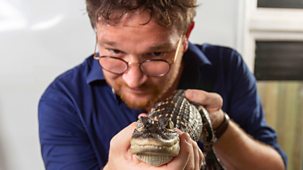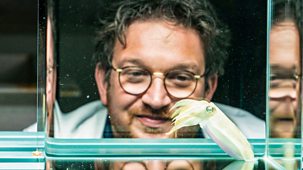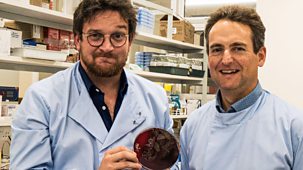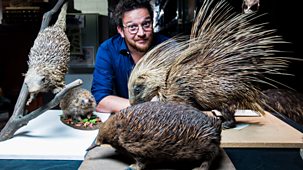
Series 1: 4. Communication
Why are male mandrill faces (big bold primates from West Africa) red and blue? How are birds' feathers so colourful? What do ringtail lemurs do to talk to one another? Their skin holds the key. As Professor Ben Garrod explores how animals communicate with one another, he uncovers a myriad more wonderful ways.\n\nSkin has evolved in some remarkable ways to enable animals to communicate with each other, from vibrant displays of colour to skin pouches to amplify sound. Ben shows how animals have evolved to use skin to make themselves heard loud and clear. Birds are notable for their use of coloured feathers to attract mates, show status and as displays of aggression. But, as Ben discovers, long before birds evolved their unrivalled use of colour, it is now believed that their ancestors, the dinosaurs, could well have been using colour to communicate. Ben also uncovers how one species of fish communicates using electricity, and a common British bird has been secretly communicating for years, without us ever knowing.
Source: BBC 4
Most recent episodes of Secrets of Skin
Secrets Of Skin
Series 1: 6. Sensing
Professor Ben Garrod explores how some snakes can see using heat, how crocodiles feel through their jaws and how some animals use electricity to navigate their world - and it is ...
03-08-2023
BBC 4
Secrets Of Skin
Series 1: 5. Defence
What is the most toxic animal on earth? How are porcupine quills helping us in medicine? Why is a rhino armour plated, and it is not to protect them from lions? \n\nProfessor Be ...
02-08-2023
BBC 4
Secrets Of Skin
Series 1: 4. Communication
Why are male mandrill faces (big bold primates from West Africa) red and blue? How are birds' feathers so colourful? What do ringtail lemurs do to talk to one another? Their ski ...
01-08-2023
BBC 4
Secrets Of Skin
Series 1: 3. Protection
How does a giraffe stay cool? What are different porcupine quills teaching us about medicine? What makes some people more likely to be bitten by mosquitoes than others? All the ...
31-07-2023
BBC 4
Secrets Of Skin
Series 1: 2. Moving
What makes sharks built for speed? How do snakes move without limbs? How do sugar gliders fly without feathers? The answer all lies in their skin. \n\nProfessor Ben Garrod uncov ...
27-07-2023
BBC 4
Secrets Of Skin
Series 1: 1. Adaptability
Skin is an incredible, multi-function organ that science is still learning so much about. It has adapted to allow animals to conquer virtually every habitat on the planet. \n\nI ...
26-07-2023
BBC 4
Most popular episodes of Secrets of Skin
Secrets Of Skin
Series 1: 3. Protection
How does a giraffe stay cool? What are different porcupine quills teaching us about medicine? What makes some people more likely to be bitten by mosquitoes than others? All the ...
31-07-2023
BBC 4
Secrets Of Skin
Series 1: 4. Communication
Why are male mandrill faces (big bold primates from West Africa) red and blue? How are birds' feathers so colourful? What do ringtail lemurs do to talk to one another? Their ski ...
01-08-2023
BBC 4
Secrets Of Skin
Series 1: 1. Adaptability
Skin is an incredible, multi-function organ that science is still learning so much about. It has adapted to allow animals to conquer virtually every habitat on the planet. \n\nI ...
26-07-2023
BBC 4
Secrets Of Skin
Series 1: 2. Moving
What makes sharks built for speed? How do snakes move without limbs? How do sugar gliders fly without feathers? The answer all lies in their skin. \n\nProfessor Ben Garrod uncov ...
27-07-2023
BBC 4
Secrets Of Skin
Series 1: 5. Defence
What is the most toxic animal on earth? How are porcupine quills helping us in medicine? Why is a rhino armour plated, and it is not to protect them from lions? \n\nProfessor Be ...
02-08-2023
BBC 4
Secrets Of Skin
Series 1: 6. Sensing
Professor Ben Garrod explores how some snakes can see using heat, how crocodiles feel through their jaws and how some animals use electricity to navigate their world - and it is ...
03-08-2023
BBC 4






